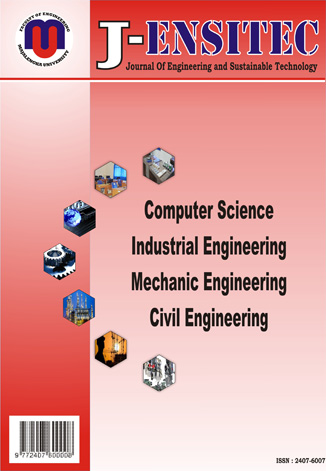STUDI PERHITUNGAN DAN IMPLEMENTASI AIRBAG PADA PELUNCURAN KAPAL TONGKANG 330 FEET BERDASARKAN STANDAR CB/T 3837-1998
DOI:
https://doi.org/10.31949/jensitec.v11i01.11541Abstract
Ship launching is a crucial stage in shipbuilding, and the airbag launching method has become widely adopted due to its flexibility, cost efficiency, and better safety compared to conventional methods. The ship launching stage is a crucial part of the ship's transition from land to sea, representing a significant innovation in the maritime field. Among the various methods available, the use of airbags has become one of the most effective and widely applied techniques. The approach taken is a quantitative approach to ensure accurate calculations in the process of launching ships using airbags. The quantitative approach aims at calculating the right number and distance between airbags to ensure the safety and efficiency of ship launching, in accordance with the industry standard C/B T 3837-1998. CB/T 3837-1998 standard can be applied to ensure stability and safety during the launching process, as well as minimize the risk of damage to the ship and ensure the launching process runs smoothly. This research aims to calculate the number and distance between airbags used in the launching of a 330-foot barge. The main ship dimensions and airbag specifications were obtained through field interviews to support accurate calculations. The results show that 18 airbags are required, with a distance between airbags ranging from 6.66 to 11.78 meters using a crossover arrangement configuration. This calculation is based on the main dimensions of the ship and the specifications of the airbags used. T
Keywords:
Airbag, Ship Launching, Barge, CB/T 3837-1998, Airbag Calculation, Airbag DistanceDownloads
References
A.S.Rashkovskyi, S. R. a., 2014. Rolling resistance of marine airbags at the longitudinal inclined slipway during ship launching. International Shipbuilding Progress , 61(1-2), pp. 41-59.
S.R.Salim & Herlina., 2024. Analisis Manajemen Risiko Operasional Bongkar Muat Menggunakan Metode HOR
A.Timothy, M. A. A. A. R. K. I., 2023. Enhancing Safety and Reliability of Marine Airbags for Ship Launching: Failure Analysis and Mitigation Strategies. International Journal of Engineering Research & Technology (IJERT), 12(9), pp. 78-81.
De Fretes, E. L. H. &. I. R., 2022. Analisis tekanan angin airbag saat peluncuran kapal. Ambon , Universitas Pattimura, pp. 25-29.
H. G. Sitepu, &. L. A. F., 2012. Kajian Penggunaan Fasilitas Dok Sistem Airbags di PT. Dok dan Perkapalan Kodja Bahari Galangan II, Jakarta.. Jurnal Riset dan Teknologi Kelautan (JRTK) , pp. 181-192.
Huang, Y. Z. H. W. H. &. W. X. (., 2011. Computation of longitudinal launching for a multi-purpose cargo ship. Applied Mechanics and Materials, pp. 783-786.
Liang, C., 2012. nfluential Factors Analysis for Airbag’s Bearing Capacity in Launching Proces. Science & Technology of Ports..
Min-h, Z., 2007. Research report of safe countermeasures to apply the airbag launch and upgrade technology to large ships, s.l.: China Shiprepair.
Ren, H. L. C. F. G. L. X. &. Z. J., 2009. Safety Assessment of Ship Launching Based on Airbags With the Nonlinear Rigidity of Airbags Being Considered. Honolulu, s.n., pp. 147-152.
Shi-lin, H., 2010. Design Issues of Airbag Launching Platform and Problems Needing Attention.. China Harbour Engineering..
STANDARD, C. 3.-1. S. I., 1998. TechnoLogical Requirements for Ship Upgrading or Launching Relying on Air-Bags,. PRC: s.n.
Sunarso Sugeng*, M. R. S. S. F. K., 2020. Technical and economic analysis of ship launching with slipway and airbag KM. Sabuk Nusantara 72. TEKNIK,, 41(3), pp. 225-231.
Yu, L. L. Y. X. L. D. J. &. Y. Q., 2015. Research on mechanics of ship-launching airbags I—Material constitutive relations by numerical and experimental approaches.. Applied ocean research, Volume 52, pp. 222-233.
Yusim, A. K. A. I. F. &. W. B. S., 2021. Analisa kebutuhan airbags untuk docking undocking kapal tongkang Virgo Sejati 177 di PT. Yasa Wahana Tirta Samudera. Riset Sains Dan Teknologi Kelautan, pp. 1-6.
Published
How to Cite
Issue
Section
License
Copyright (c) 2024 Mohamad Alif Dzulfiqar, Nur Fitri Pujo, Nurman Pamungkas, Husen, Mufti Fathonah Mufariz, Nurul Fadhilah

This work is licensed under a Creative Commons Attribution-ShareAlike 4.0 International License.
An author who publishes in the J-ENSITEC (Journal of Engineering and Sustainable Technology) agrees to the following terms:
- Author retains the copyright and grants the journal the right of first publication of the work simultaneously licensed under the Creative Commons Attribution-ShareAlike 4.0 License that allows others to share the work with an acknowledgment of the work's authorship and initial publication in this journal
- The author is able to enter into separate, additional contractual arrangements for the non-exclusive distribution of the journal's published version of the work (e.g., post it to an institutional repository or publish it in a book) with the acknowledgment of its initial publication in this journal.
- The author is permitted and encouraged to post his/her work online (e.g., in institutional repositories or on their website) prior to and during the submission process, as it can lead to productive exchanges, as well as earlier and greater citation of the published work







